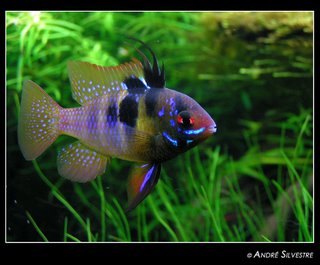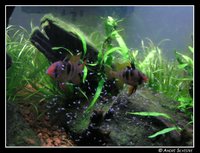
Common name: Blue Ram, German Blue Ram
Scientific name: Microgeophagus ramirezi
Geographic location: Venezuela, Columbia
Size: Up to 5cm (2 inches)
Temperament: Peaceful
Conditions: 75-85F, pH 6.5-7.0
Skill Level: Advanced
Minimum Tank Size: 10-20 gallons
 The Blue Ram is a dwarf cichlid from South America, although it is now captively bred in Europe and Asia. It is a mainly peaceful fish that thrives in well planted tanks with softer water. In the wild, it lives in warm pools that are heated by the sun, so it is tolerant of higher temperatures. These fish are very complex fish behaviorally, which makes them a pleasure to own and watch. Often, they are not afraid of a hand in the tank like other more skittish fish and will hold their own against much larger, more aggressive fish. Males and females look similar, except males have a longer black spike on their dorsal fin and have no blue markings in their black spot on their side. Blue Rams form faithful pairs and are quite easy to breed in the aquarium.
The Blue Ram is a dwarf cichlid from South America, although it is now captively bred in Europe and Asia. It is a mainly peaceful fish that thrives in well planted tanks with softer water. In the wild, it lives in warm pools that are heated by the sun, so it is tolerant of higher temperatures. These fish are very complex fish behaviorally, which makes them a pleasure to own and watch. Often, they are not afraid of a hand in the tank like other more skittish fish and will hold their own against much larger, more aggressive fish. Males and females look similar, except males have a longer black spike on their dorsal fin and have no blue markings in their black spot on their side. Blue Rams form faithful pairs and are quite easy to breed in the aquarium.I have owned many of these fish, and they are incredibly beautiful and fun to watch, but require patience, persistence, and advanced fish-keeping skills. Where they are purchased makes a big difference. Only buy them from a reputable dealer, or even better, a hobbyist who has bred the fish themselves. Otherwise they are very prone to carrying parasites or just being weak due to over-breeding and will end up dying in a few weeks. Most come from farms in Asia where they treat them with hormones to make them look more colorful at a younger age. This may lead to all sorts of health problems. It's a good idea to quarantine them before you put them in with other fish and even a preventative parasite treatment, like Jungle Labs Parasite Clear, can eliminate infections and increase chances of survival. Having a full range of medications on hand is advised with this fish, as they tend to get sick easily, unless you get strong specimens.
 Once you get past the difficult first few months, you can start thinking about breeding these fish. I've never been able to successfully breed and raise the fry, the hardest part is getting the eggs to hatch and then finding something small enough for them to eat. They do become quite aggressive once they have spawned, so keeping them in a tank of their own is a good idea. Pairing together a male and female is often difficult; just throwing two together doesn't always make a pair (much like real life!). Spawning can be induced by doing a water change with slightly cooler water (simulating a rainstorm). Eggs will be laid overnight often on a flat surface and should hatch within 7 days. Feeding the fry is difficult because most foods are too big to fit in their mouths, but they will eat infusoria (little bugs present in all aquariums, often too tiny to see) and also microworms. They grow very slowly, and unless you separate the male and female, they will be ready to spawn again in a few weeks and eat all of their young fry! If you can manage to get through these crucial stages, you will be greatly rewarded with healthy rams that can be traded, sold, or used for breeding.
Once you get past the difficult first few months, you can start thinking about breeding these fish. I've never been able to successfully breed and raise the fry, the hardest part is getting the eggs to hatch and then finding something small enough for them to eat. They do become quite aggressive once they have spawned, so keeping them in a tank of their own is a good idea. Pairing together a male and female is often difficult; just throwing two together doesn't always make a pair (much like real life!). Spawning can be induced by doing a water change with slightly cooler water (simulating a rainstorm). Eggs will be laid overnight often on a flat surface and should hatch within 7 days. Feeding the fry is difficult because most foods are too big to fit in their mouths, but they will eat infusoria (little bugs present in all aquariums, often too tiny to see) and also microworms. They grow very slowly, and unless you separate the male and female, they will be ready to spawn again in a few weeks and eat all of their young fry! If you can manage to get through these crucial stages, you will be greatly rewarded with healthy rams that can be traded, sold, or used for breeding.Images used with permission of André Silvestre</font>


hi
ReplyDeletemy rams laid the eggs and the eggs hatched in 3 days time.
sadly, during the night, the parents guided the fry into the substrate to sleep and the substrate which was toxic killed them all. this happened twice. I thought the first failure was due to my other fish eating them up but realize that after removing them, they still died on the second time.
guess i need to buy some sand and layer it on top of the substrate. will this kill my plant? i heard that if the crowns of the plant are covered, they would die. what should i do to prevent the fries from swimming into the substrate?
I would suggest letting the parents lay there eggs and then seperate the item the eggs are on to a seperate tank.
ReplyDeleteIt is best to rear fry in a bare tank with no substrate and a sponge filter. It is also a good idea to put formalin or acriflavin in the water to prevent fungus growth on the eggs. Frequent water changes are necessary. As always, pay close attention to water chemistry and temperature. Use special care not to suck up any fry. You will need to feed very small feed like infusoria or microworms for the first few days. You can then feed baby brine shrimp.
pathetic!!! rams r the easiest fish to breed i've done for 15 years!!!
ReplyDeleteAnything helpful to add or did you just want to shout about how fantastic you are?
DeleteSomebody asks for help and you tell them that they are pathetic! Lucky for you that you were automatically an expert to start with and never had to ask for help or advice. Most normal people accept that they are on a learning curve with a new venture then use forums such as this to develop their skills. It's a shame that the likes of you try to belittle them for doing so.